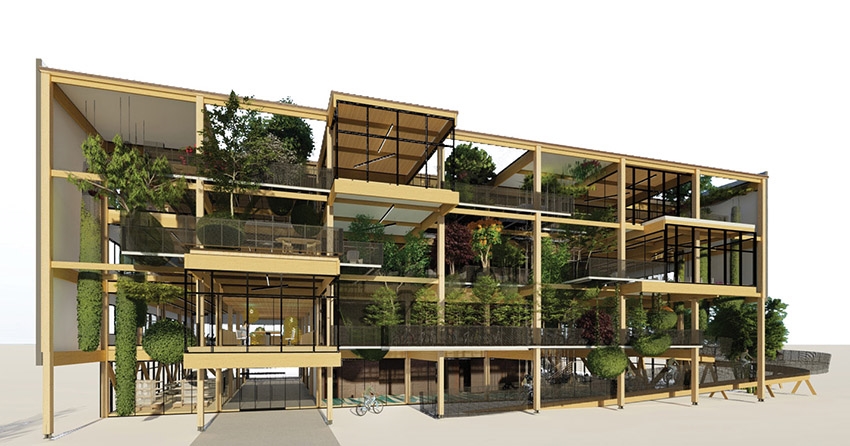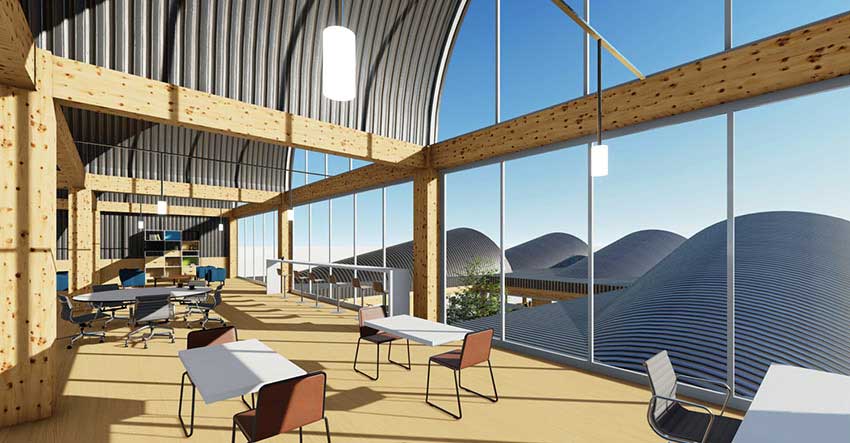
A proposal focused on reimagining common building types as mass timber projects was recognized in the 2021 Green Good Design Awards.
The U of A Community Design Center, working in collaboration with the U of A Resiliency Center, has been awarded a 2021 Green Good Design Award for Green Research/Technology by the European Centre for Architecture Art Design and Urban Studies and the Chicago Athenaeum: Museum for Architecture and Design.
The Green Good Design awards focus on "the most important new international products and buildings and construction and planning projects that are leading the global way to a design that is fully sustainable and compatible with the highest standards of good environment," the awards release states. A jury composed of The European Centre's International Advisory Committee selected more than 150 new buildings, landscape projects and product designs from 28 nations for recognition in the awards program.
The U of A's winning project, "Wood City: Timberizing the Standard Real Estate Product Types," examines the question: "What if cities were built from the only building construction system that sequesters carbon and can be engineered to be 'energy positive' — wood?" The project rethinks common building typologies using mass timber as an alternative to concrete, steel and light-framed wood construction.
The Community Design Center is an outreach program of the Fay Jones School of Architecture and Design at the U of A led by Stephen Luoni. Luoni is also a Distinguished Professor and the Steven L. Anderson Chair in Architecture and Urban Studies.
The project was a collaborative effort between the Community Design Center and the U of A Resiliency Center, an interdisciplinary sustainability initiative hosted by the Fay Jones School and led by executive director Marty Matlock. Matlock is also a professor in the Department of Biological and Agricultural Engineering in the College of Engineering at the university.
Fay Jones School architecture students Matthew Scott, Mary Grace Corrao, Wenjie Zhu, Keturah Bethel and Jacob Alford also worked on the "Wood City" project through a studio conducted at the Community Design Center.
This is the fifth time that a collaborative project by the Community Design Center and Resiliency Center has received a Green Good Design Award. The Wood City project was sponsored by the Weyerhaeuser Giving Fund.
The goal of "Wood City" is to showcase design applications of mass timber construction among standard real estate products — the architectural building blocks of America's built environment. The objective goes beyond retrofitting these commercial typologies with a sustainable construction system and includes exploring related issues in the development of cities, including "negative externalities" like pollution, high fossil fuel use, sprawling land use, planned obsolescence and ugliness, Luoni said.
 Timber civilizes packaged metal building systems through new public frontage vocabularies and warm interiors. Rendering by Mary Grace Carrao. |
Current innovations in timber-engineered buildings have primarily focused on tall buildings, institutional and commercial structures, and custom homes. However, Luoni said, the ordinary low-rise building typologies common in low-density, vehicle-reliant landscapes hold the key to revolutionizing the carbon footprint through better building, urbanism and land use.
"Rather than begin with large-scale planning, 'Wood City' begins with the 19 standard real estate products comprising 80 percent of our built environments — fast food restaurants, storage facilities, multifamily apartments, metal warehouses, big-box retail, single-family houses, etc. — to rethink the entire city as a carbon sink," Luoni said. "Since mass timber buildings effectively sequester carbon, center partners, staff and students partnered to triangulate research in building prefabrication with future retrofit of suburbs and social evolution of common building types beyond simple logistics. Fast food restaurants became food halls accommodating food trucks and outdoor gathering; strip shopping centers became neighborhood centers; metal warehouse systems were hybridized to accommodate public functions; and assisted living facilities absorbed lessons from the hospitality industry."
Mass timber technology can play a key role in ensuring that the massive levels of resources the United States will allocate to building the next generation of human settlements — close to $1.5 trillion just in 2020 — are not squandered by poor practices in energy conservation, carbon reduction, ecosystem stewardship, nonrenewable resource conservation and climate change mitigation, Luoni said.
The award-winning projects will be exhibited through June 15 at the European Centre for Architecture Art Design in Athens and will be featured in the upcoming book Green Good Design 2021, to be published by Metropolitan Arts Press Ltd.
The Green Good Design Awards program aims to bring public appreciation and awareness to global design projects that emphasize sustainability and ecological restoration.
Topics
Contacts
Shawnya Lee Meyers, digital media specialist
Fay Jones School of Architecture and Design
479-575-4744, slmeyers@uark.edu
Michelle Parks, director of communications
Fay Jones School of Architecture and Design
479-575-4704, mparks17@uark.edu